Chemical units are employed
to enhance combat power. Combat power is the ability to fight
and is achieved by combining maneuver, firepower, protection,
and leadership. Through proper employment, chemical units are
significant combat multipliers. Chemical units increase combat
capabilities on the battlefield by reducing the effects of NBC
weapons and making enemy target acquisition less effective. Chemical
units are used at brigade/regiment, division, corps, and echelons
above corps. Chemical units provide decon, large area smoke, NBC
reconnaissance, and staff support.
NBC operations on the battlefield
will create tremendous challenges. Unit NBC defense training,
chemical staff planning, and proper and effective use of chemical
units and staff personnel will greatly reduce the effects of NBC
weapons.
GENERAL PRINCIPLES
Task-organize chemical
units to requirements
Mission requirements drive
size and composition of chemical units. A mix of different units
(smoke, decon, and NBC recon) is often necessary to achieve the
proper balance of capabilities. This mix can change as the operation
progresses.
Give priority to the
main effort
There are never enough chemical
units to handle all tasks. Chemical units are spread evenly across
the battlefield, but are concentrated with the main effort to
ensure success. This requires accepting risk elsewhere.
Integrate chemical units
with maneuver and fire
The scheme of maneuver governs
the chemical support plan. Smoke and NBC recon elements enhance
the effectiveness of fire and maneuver. Chemical units will operate
well forward in the combat zone and will require the protection
offered by fire and maneuver.
Ensure current chemical
support operations promote future force operations
Chemical units and staffs
must anticipate future missions and reposition their units, if
necessary, while accomplishing the current mission. The positioning
of decon sites should not interfere with future operations.
Do not hold smoke and
NBC recon units in reserve
Chemical units, especially
smoke and NBC recon, do not remain with forces that are not in
the fight. They remain out of action only long enough to refit
after a major action.
Build a logistically
sustainable force
Resources are always limited.
Chemical units cannot sustain themselves and require support from
other organizations. Chemical unit sustainment and the supporting
logistics structure must be planned in detail. Logistic limitations
may restrict the size of the supporting chemical unit.
Maintain effective battle
command
Effective plans use all available
chemical unit headquarters, align them with maneuver boundaries,
and hand off operations smoothly between them.
Use all local resources
Chemical units, particularly
decon units, need to use local resources. Host nation support
should always be considered and used when available. Use of host
nation chemical support in the rear areas can release more chemical
units forward to the combat zone.
COMMAND AND CONTROL HEADQUARTERS
Chemical unit control headquarters
(chemical brigade HHC and chemical battalion HHD) are employed
to provide command, control, and coordination for subordinate
chemical units. These organizations also provide certain logistical
support and facilitate the coordination of logistical support
for their subordinate units. This allows the supported unit's
chemical staff to concentrate on NBC defense planning and execution
rather than logistical support for supporting chemical units.
The chemical brigade HHC can
control up to six chemical battalions and is normally allocated
to a corps. In contingency operations it is possible that the
chemical brigade HHC could be allocated to the theater army (Army
component commander) commander to control all chemical assets
in the theater.
The chemical battalion HHD
can control up to five chemical companies and detachments. Chemical
battalion HHDs are allocated to a corps based on the number of
chemical companies assigned. As seen in Operation Desert Shield/Storm,
it is possible that the chemical battalion HHD will be the senior
chemical command and control element in a corps.
Having a chemical battalion
HHD instead of a chemical brigade HHC in support of a corps
means --
- The corps chemical staff assumes
a greater role in planning and coordinating chemical unit operations,
to include the coordination of logistical support to the chemical
units.
- Chemical battalion HHD communications
assets are not as robust as the chemical brigade's. This limits
the responsiveness and flexibility of supporting chemical units.
SMOKE UNITS
Smoke Operations
The mission of smoke units
is to generate large-area smoke screens. These smoke screens decrease
friendly force vulnerability and/or degrade threat force's command,
control, communication, and intelligence capabilities from the
forward to the rear areas of the battlefield. Smoke is used on
the battlefield to--
- Obscure.
- Screen.
- Protect.
- Mark.
Smoke support provided by
smoke generator units should be integrated with other available
smoke-producing assets. Such assets include artillery- and mortar-delivered
smoke projectiles, smoke pots, and vehicle self-protection smoke
systems. These assets should be integrated with the preceding
employment concepts to achieve the most effective smoke support.
For further information concerning
smoke operations, see FM 3-50, Smoke Operations.
Smoke Unit Employment
Both motorized and mechanized
smoke generator units can produce either fixed-area or mobile
smoke screens as required. Mechanized smoke units are best employed
supporting maneuver forces, while motorized smoke units normally
support units not engaged in close combat. Motorized smoke units
in support of motorized and light units do operate well
forward. However, these are not strict rules. Smoke units will
be employed wherever needed to support a maneuver force. This
does not mean they will operate across the FLOT on their own.
Smoke units should never be kept in reserve. Units unable to use
their supporting smoke units for whatever reasons should return
control of the smoke unit to their higher headquarters.
Before beginning the planning
process, the smoke unit leader needs the following items of information
from the supported unit--
- Commanders intent.
- Location and size of the area
to be screened.
- The time smoke coverage is
required.
- Duration of smoke coverage.
- Visibility desired within
the screen.
- Operational activities of
the supported unit.
Using this information, the
smoke unit leader issues a warning order to his unit. He initiates
a recon of the operational area in as much detail as time and
the situation permits. Depending on coordination required, the
entire planning process can take a few minutes or a few hours.
The objective or selected
area or areas to be concealed are located during the recon. This
is necessary to determine weather and terrain information. Based
on this information and the supported unit's visibility requirements,
the spacing between smoke generator systems and minimum distance
from these systems to the area to be concealed can be calculated.
This calculated distance is a guide only. Actual locations of
individual smoke generator systems are determined by using METT-T.
All smoke generator units
depend on the wind to carry the smoke over the area to be concealed.
Alternate positions for smoke generator systems must be planned
to provide the required coverage for any wind direction. Obviously,
it is not possible to use these alternate positions for every
operation because of untrafficable terrain, enemy troop locations,
and other factors. In such cases, plans must include the use of
other smoke sources, such as smoke pots or artillery- or mortar-delivered
smoke projectiles.
During fixed-area screening
operations, units use primary and alternate smoke positions.
Figure 2-1 illustrates how a motorized smoke platoon plans coverage of
a brigade support area (BSA). The smoke platoon occupies the primary
smoke line. The alternate smoke lines provide overall coverage
in the event that wind shifts.
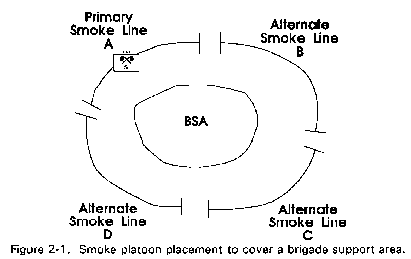
Mobile smoke operations use
primary and alternate positions for each smoke source.
Figure 2-2 illustrates how a corps mechanized smoke company plans coverage
of a brigade task force assaulting an enemy strongpoint. In this
case, because of the threat, alternate positions cannot be planned
to ensure coverage of the required areas for any wind direction.
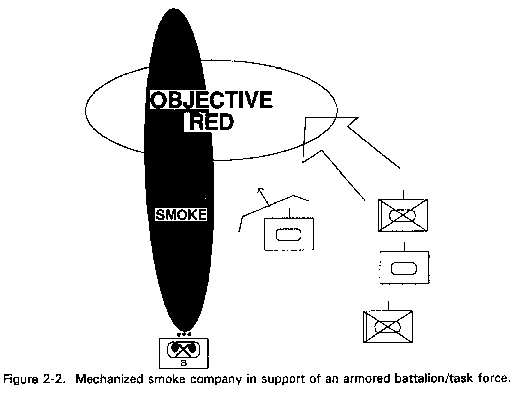
DECON UNITS
Decon Operations
There are three types of decon:
immediate, operational, and thorough. Decon units provide operational
& thorough decon support. Decon operations are planned and
executed following these principles. Decontaminate--
- As soon as possible.
- Only what is necessary.
- As far forward as possible.
- By priority.
Operational Decon. The objective of operational decon is to remove just enough of
the contamination to allow soldiers to sustain operations. Operational
decon should begin at the earliest opportunity. Rapid decon reduces
the potential for delayed injuries and casualties, thus enhancing
unit effectiveness. Operational decon uses two decon techniques--MOPP-gear
exchange and vehicle washdown. It requires support from the battalion-level
power-driven decon equipment (PDDE) crew or from a decon squad
or platoon.
An unsupported vehicle washdown
occurs when the contaminated unit uses its organic equipment to
conduct the washdown. A supported vehicle washdown is when the
assets from a decon unit are used. A decon unit may support operational
decon operations when--
- The contaminated unit's decon
equipment and resources are unable to process their contaminated
vehicles in a timely manner.
- If the mission of the maneuver
unit is critical and limited by time, the operational supported
concept will speed the decon process.
- The contaminated unit does
not have the equipment or their equipment is not serviceable.
Thorough Decon. Thorough decon is the process of reducing the contamination hazard to a
negligible risk. Thorough decon uses two techniques - detailed
troop decon (DTD) and detailed equipment decon (DED). DTD is the
process of decontaminating individual soldiers. DED is the process
of removing or neutralizing contamination on the interior and
exterior surfaces of unit equipment. A contaminated unit undergoing
DED and DTD can allow MOPP reductions for extended periods. Thorough
decon operations are conducted by decon units with support from
the contaminated unit. The contaminated unit will set-up and run
the DTD line with guidance (if needed) from the supporting decon
unit.
Decon units can conduct thorough
decon operations under three different situations: after combat
operations, during reconstitution, and during a passage of lines.
These three situations present different considerations for command
and control, management of supplies, resources and planning of
decon operations,
Thorough decon after combat
operations. A mission
capable unit (for example, a field artillery battery) has been
contaminated. The battery is needed for an upcoming high priority
mission. However, the contamination does not allow the unit to
perform at 100 percent of its capability because of MOPP degradation.
The decision is made to support
the contaminated unit with thorough decon to restore its combat
power by lowering the contamination to a negligible risk. The
decision to support this battery with thorough decon operations,
in this situation, probably will be made at division level. The
exact setup of the thorough decon site is dependent on METT-T
(the friendly and enemy tactical situations, the number of contaminated
vehicles and personnel, the number of decon platoons available,
and the time available to conduct the decon).
Thorough decon during reconstitution.
Reconstitution consists
of reorganization, assessment and regeneration. Thorough decon
operations are conducted during the reorganization and/or regeneration
process. Operations that support regeneration of combat power
may involve support to units that are contaminated. The contaminated
units may not be capable of providing unit personnel to the detailed
equipment decon line because of combat losses. To minimize the
transfer or spread of contamination, thorough decon will occur
before the sustainment activities (that is, manning, supplying,
maintaining).
Additional personnel will
be provided as needed to man decon lines and operate vehicles
to accomplish thorough decon. This decon process will occur forward
from the designated assembly area before the contaminated unit
goes through the large scale replacement of personnel, equipment,
and supplies. Corps- and division-level decon units can provide
decon support during reconstitution operations.
Thorough decon during a
passage of lines. A
unit conducting a rearward passage of lines under enemy pressure
has encountered contamination during its movement. The principles
"decon as far forward as possible" and "decontaminate
as soon as possible" apply in this case. The division (or
higher) makes the decision to execute operational decon forward
to limit the spread of contamination and unit degradation. The
operational decon site is established near the end of the passage
lane and out of enemy direct fire. See figure 2-3.
Once operational decon operation
is completed, the contaminated unit can proceed without spreading
contamination. Prior to arrival at the tactical assembly area,
the contaminated unit will conduct thorough decon.
For further information concerning
decon operations, see FM 3-5, NBC Decontamination.
Decon Unit Employment
Decon units are employed based
on METT-T. By determining the threats capability and ability to
employ ground contaminating chemical agents, a threat assessment
is made. Depending on the threat assessment, decon units are allocated
and positioned. There are two techniques for employing decon units:
centralized and decentralized. Under centralized operations, decon
units are controlled at the highest levels. Units needing decon
support request the support from the controlling headquarters.
The controlling headquarters analyzes the request for support.
Once the decision is made to provide decon support, a decon unit
is given the task of providing the requested support. Under decentralized
operations, decon units are positioned around the battlefield
based on METT-T. Control of the decon units is passed to subordinate
units.
Centralized operations are
best used when--
- The NBC threat is vague or
unknown.
- There are insufficient decon
assets to support each major subordinate command with dedicated
assets.
- The controlling commander
wants to retain maximum flexibility at his level.
Decentralized operations are
best used when--
- There is a well-defined NBC
threat.
- The controlling commanders
want their subordinates to have maximum flexibility in employing
decon assets.
- Time and space prevent the
higher headquarters from providing responsive decon support.
- Communications between higher
and subordinate units may not allow responsive decon support.
All echelons must conduct
some planning and preparation for conducting decon operations.
Most decon planning is conducted at the levels that have control
of decon units. Decon planning is conducted as part of the overall
planning process. The commander should provide guidance on decon
to the chemical staff early in the planning process. The commander's
guidance should indicate under what circumstances operational
or thorough decon operations will be conducted and their priorities
for decon support.
For example, "if the
maneuver forces become contaminated during the attack, they'll
continue to fight dirty until after the objective is secured.
We then conduct thorough decon as necessary while preparing for
the next operation. Artillery units contaminated during the battle
may require operational decon support so that they can sustain
operations. Priority of decon support is to artillery, CSS, C2,
and maneuver units". From the commander's general guidance
concerning decon, the chemical staff officer and the chemical
unit commander can begin to develop the decon plan.
The chemical staff will select
possible decon sites throughout their area of operations. The
selection of the decon sites is based upon the type of decon operation
(operational or thorough), terrain, the scheme of maneuver, the
threat, the road network, and the availability of water. After
the decon sites are selected, link-up points are chosen to support
each decon site. It is possible that one decon site may have more
than one associated link-up point. The selection of the link-up
points requires careful consideration. The decon link-up points
must be easily recognizable to all parties.
Since the total decon capability
of any unit is limited, the commander must establish a priority
of decon support. The priority of support can change from phase
to phase during an operation. The chemical staff develops the
priority of support by determining the decon technique to be used
(operational or thorough), the threat (what units are likely to
become contaminated and when), and the likelihood the unit can
accomplish decon. To give priority of support to the lead force
during the assault phase may not be the best choice since elements
of the task force that become contaminated will most likely not
stop to accomplish decon until after the assault is completed.
The commander should establish a priority of work that specifies
the order vehicles are decontaminated. A priority of work may
look like this: Engineer equipment, Ml, M2, FIST-V. The priority
of work also may vary from phase to phase of the operation.
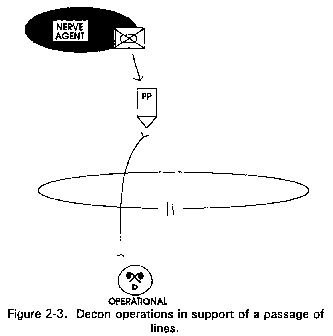
A limiting factor that must
be considered when planning any decon operations is the availability
of water. FM 3-5 states that 550-gallons of water per vehicle
is used during a thorough decon. This is a good planning factor,
but it also must be recognized that the amount of water required
will vary by type of vehicle. A HWMMV will require less water
than an M 1 tank, and a 5,000-gallon fuel tanker will require
a lot more water than 550-gallons. The chemical unit/staff must
develop a water resupply plan. In a water-rich environment, such
as Europe, it is as easy as identifying water sources where the
decon platoon can obtain water.
In a water-scarce environment,
such as the Middle East, the chemical unit/staff must coordinate
a water resupply plan with the G4/S4. A water resupply plan can
be as simple as selecting a series of link-up points along the
MSR where the decon platoon can link-up with bulk water trucks
from a support unit. More complex water resupply plans include
linking up with bulk water trucks, caching water throughout the
area of operations, coordinating for the movement of water bladders
by aircraft to the decon sites, and the identification of water
sources in the unit's area of operation. At times, when the need
for decon water is critical, reprioritization of potable water
from such sources as laundries and baths may become necessary
in order to temporarily meet needs.
The positioning of the decon
platoon on the battlefield is an integral part of the decon plan.
The initial position of the decon platoon is based on the unit's
mission, what unit has the priority of support, and the persistent
chemical threat. The chemical staff also must consider the range
of the enemy's indirect fire systems and the time the decon platoon
requires to move and set up. One technique is the use of phase
lines or decision points to trigger the movement of the decon
platoon to subsequent decon sites.
The decon plan can be issued
in several different formats. One technique for distributing the
brigade decon plan is to use an execution matrix that lists the
decon site(s), link-up point(s), decon technique, priority of
support, and work by phase or event. Decon sites and link-up points
must be included on the combat service support graphics.
Deconfliction of proposed
decon sites is critical at all levels. Decon sites should support
the scheme of maneuver and not interfere with future operations.
Subordinate units should clear their proposed decon sites with
their higher headquarters to avoid duplication and ensure that
the locations do not interfere with future operations.
The decon unit leader should
conduct a recon of the proposed decon sites. Since the chemical
staff is selecting decon sites by map reconnaissance, the proposed
sites may not be suitable. If the proposed sites cannot support
decon operations, the decon unit leader should attempt to find
another site close to original site. The decon unit leader should
never change the location of the decon site without coordination
with the supported unit's chemical staff. Link-up points should
only be changed as a last resort.
The decon unit leader should
attend all the supported unit's rehearsals whenever possible.
At a minimum the decon unit leader must have the supported unit's
operations and combat service support graphics posted on its map.
The actual decon operation
begins once a unit has become contaminated. The contaminated unit's
leaders must assess their situation and accurately report their
status to their headquarters. While the unit may not be able to
conduct decon during the battle, the decon unit can reposition
and begin preparation to process the contaminated unit.
The request for decon support
must contain several essential elements of information to assist
the chemical staff and the decon unit leader in coordinating the
decon operation. These essential elements of information are--
- Designation of the contaminated
unit.
- Location of the contaminated
unit.
- Time unit became contaminated.
- Earliest possible time the
unit can move/begin decon.
- Type of contamination.
- Number of contaminated vehicles
by type.
- Number of personnel and casualties
contaminated.
- Special requirements (recovery
assets, unit decon team, for example.).
Upon learning of a unit being
contaminated, the controlling headquarter's chemical staff must
begin coordinating the decon operation. The decon unit is given
a warning order. Subsequent warning orders provide more detailed
information to the decon unit. After receiving the request for
decon support, the controlling unit's chemical staff will issue
an order to the decon unit. One technique is to have a message
format in the SOP that contains all the information necessary
to the decon unit to coordinate and execute the mission
(Figure 2-4).
The controlling unit's chemical
staff must decide if the decon unit is correctly positioned to
support the contaminated unit. This is determined by the locations
of the contaminated unit and the decon unit and the impact of
moving the contaminated unit to the decon site. If the decon unit
is not in position to support the contaminated unit, it must move
as quickly as possible to a decon site that will support the operation.
The chemical staff must coordinate the movement of the contaminated
unit to the link-up point and the decon site. Depending on the
size and type of unit contaminated, the chemical staff may issue
a warning order to any elements involved in the water resupply
plan.
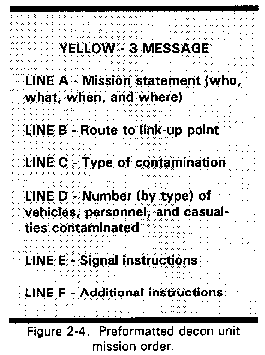
Once the decon unit is in
position and set up, the decon unit's representative moves to
the link-up point. The most difficult part of the decon operation
is the link-up between the contaminated unit and the decon element.
All elements supporting the decon (medical, recovery, logistical,
and so forth.) should not be directed to the link-up point unless
they are contaminated. Supporting assets must coordinate with
the decon unit to be met and led into the decon site. The contaminated
unit's higher headquarters must dispatch a command and control
cell to the decon site to supervise the decon operation. Movement
of units (decon and contaminated) must be coordinated with the
G3/S3, engineers, and subordinate headquarters when units will
cross boundaries.
After link-up is achieved
and all support assets are in position, the actual decon operation
can commence. The decon unit's leader, in conjunction with the
supported unit's command and control cell supervise the decon
operation. The controlling unit's chemical staff must assert staff
supervision during all phases of the decon operation.
NBC RECONNAISSANCE UNITS
NBC Reconnaissance Operations
NBC recon operations support
the NBC principle of contamination avoidance. NBC recon provides
commanders with freedom of maneuver and minimizes the degradation
from operating under NBC conditions. NBC recon operations include
search, survey, surveillance, and sampling missions.
NBC recon is a mission undertaken
to obtain militarily significant information about the NBC condition
of routes, areas, and zones. This information confirms or denies
the presence of NBC attacks or hazards with detection and identification
equipment. Visual observation or the collection of samples in
the specified location or region can also provide this information.
NBC surveys are missions conducted to collect detailed information
of NBC contamination hazards. The survey determines the type of
contamination, the degree (extent/intensity), and the boundaries.
NBC surveillance is the systematic observation of an area to provide
early warning. Sampling operations provide physical evidence of
NBC attacks and technical intelligence concerning the enemy's
NBC weapons systems.
NBC Reconnaissance Unit
Employment
During offensive operations,
NBC recon units will operate throughout the framework of the battlefield.
In the forward combat area, NBC recon elements are integrated
into the overall recon and surveillance effort. NBC recon units
are generally employed to either--
- Confirm or deny contaminated
areas.
- Confirm the area is clear
of contamination.
Whatever the method of employing
NBC recon units, efforts must be focused by the IPB and the supported
commander's priority intelligence requirements (PIR) and intelligence
requirements (IR).
The capabilities and limitations
of the NBC recon systems must be considered when developing the
plan. NBC recon platoons can be employed at platoon, section,
squad, or team levels. When employed at the team level, it will
be paired with an overwatch partner. Both M93 NBCRS (Fox) and
M113-equipped units can be used to support maneuver forces. HMMWV-equipped
units are best employed at the squad and platoon levels. Because
HMMWV-equipped units are less survivable, they are best employed
with similar light and motorized maneuver forces or in rear areas.
The Fox can rapidly detect and identify chemical contamination.
M113-and HMMWV-equipped units do not have the ability to rapidly
detect and identify contamination.
Confirm or deny contaminated
areas. When the NBC
IPB identifies possible contaminated areas in the area of operations,
NBC recon can be employed to confirm or deny the presence of contamination.
Templated contaminated areas that could affect the scheme of maneuver
are designated as Named Areas of Interest (NAI). These NAIs are
included in the Reconnaissance and Surveillance (R&S) Plan.
Supporting NBC recon elements are tasked in the R&S Plan to
observe selected NAIs. The NBC recon can observe the designated
NAIs through physical recon or by observation. If the NBC recon
element conducts a physical recon of the NAI, the supporting unit
may have to provide security. Detailed coordination with other
recon assets is required to prevent duplication and fratricide.
Confirm the area is clear
of contamination. NBC
recon elements are integrated into the combat formation. They
move behind or with the lead maneuver force. If the formation
encounters contamination, the NBC recon can deploy to find clear
by-pass routes around the contaminated area. The lead maneuver
force provides security as the NBC recon elements attempt to find
a by-pass route. Once the by-pass route is located, the NBC recon
is integrated back into the formation in case there are additional
contaminated areas.
In the rear areas NBC recon
units are employed to allow the supported commander to retain
the freedom of maneuver. NBC recon efforts are again focused by
the IPB and the R&S plan. NBC recon elements can be positioned
throughout the rear conducting NBC surveillance missions. Main
supply routes (MSRs) and other vital routes can be monitored for
contamination by periodically patrolling the routes.
During defensive operations,
NBC recon elements can be assigned NBC surveillance missions behind
the main defensive positions to observe designated NAIs for NBCactivity. Once NBC activity is observed, the NBC recon element
can be employed to confirm or deny the presence of chemical agents.
If contamination is found, the elements can find clear by-pass
routes and mark the contaminated area. This gives commanders the
freedom to maneuver behind their main defensive area. NBC recon
elements may support to counterattack forces to rapidly find by-pass
routes if contamination is encountered.
In the corps and TA rear area
NBC recon units will conduct NBC recon operations along MSRs and
at critical points. They also respond to reports of NBC attacks
to determine the type and extent of contamination. Additionally,
NBC recon units may be assigned NBC surveillance missions to observe
designated areas for NBC attacks. Areas to be occupied by logistics
and C2 facilities can be checked for NBC hazards.
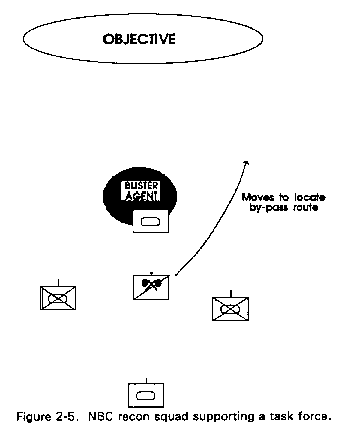
NBC recon units can perform
conventional recon missions. After NBC warfare has been initiated,
the employment of NBC recon units in conventional recon roles
must be approved by corps/division commanders.
Chemical units may be reorganized
to function as a reaction force to defeat up to level II and delay
level III rear area threats (see Figure 2-6 for rear area threat
levels). Additionally, chemical units can assist in area damage
control (ADC). The decision to reorganize chemical units must
be carefully weighed against the current NBC threat. The reorganization
decision is made by the parent organization.
Response forces are the initial
force to respond to a threat within their area of operations.
This force destroys the enemy within their capability. If the
attack is by an enemy force beyond the capability of the response
force, the response force will--
- Delay and disrupt the enemy
force.
- Request additional support
from the rear area operations center (RAOC).
- Attempt to learn the size
and intent of the enemy force.
Once reorganized, chemical
units will come under the control of a RAOC. The RAOC will position
the response force on the battlefield to provide security and
react to enemy rear threats. FM 90-14, Rear Battle provides
an in-depth discussion of rear battle operations.
Area damage control are those
actions taken before, during, and after hostile action or natural
disasters to reduce the probability of damage and to minimize
its effects. Chemical units can respond to the affected area and
provide immediate assessment of the damage. Decon units can provide
limited fire-fighting services. NBC recon units can determine
the type and extent of hazards if NBC weapons were used or commercial
chemicals involved. Decon units can establish decon sites as necessary.
The RAOC for the affected area will establish command and control
over units providing ADC support.
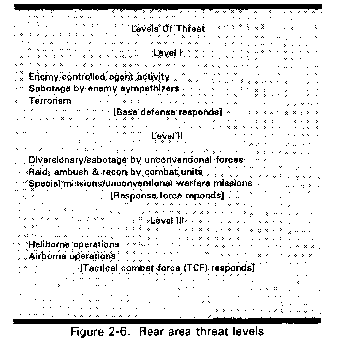
|
NEWSLETTER
|
| Join the GlobalSecurity.org mailing list |
|
|
|

